英语人教版七年级下册第九单元教案
- 格式:docx
- 大小:10.80 KB
- 文档页数:3
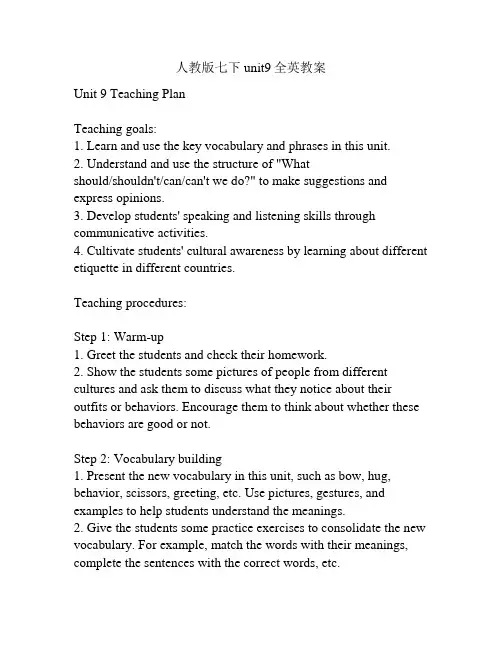
人教版七下unit9全英教案Unit 9 Teaching PlanTeaching goals:1. Learn and use the key vocabulary and phrases in this unit.2. Understand and use the structure of "Whatshould/shouldn't/can/can't we do?" to make suggestions and express opinions.3. Develop students' speaking and listening skills through communicative activities.4. Cultivate students' cultural awareness by learning about different etiquette in different countries.Teaching procedures:Step 1: Warm-up1. Greet the students and check their homework.2. Show the students some pictures of people from different cultures and ask them to discuss what they notice about their outfits or behaviors. Encourage them to think about whether these behaviors are good or not.Step 2: Vocabulary building1. Present the new vocabulary in this unit, such as bow, hug, behavior, scissors, greeting, etc. Use pictures, gestures, and examples to help students understand the meanings.2. Give the students some practice exercises to consolidate the new vocabulary. For example, match the words with their meanings, complete the sentences with the correct words, etc.Step 3: Reading and listening1. Have the students read the text "Etiquette around the world" silently and underline the key information. Then discuss in pairs about what they have learned.2. Play the listening material for the students to listen and match the countries with their customs. After listening, check the answers with the whole class.Step 4: Speaking practice1. Divide the students into groups and have them discuss the questions in Activity 3 on page 64. Encourage them to express their opinions and give reasons for their choices.2. Role play: Have the students work in pairs and act out a conversation where they make suggestions about etiquette in different situations. For example, one student can be a visitor and the other can be a local person. They can discuss what the visitor should or shouldn't do.3. Group presentation: Assign each group a country and have them research and present on the etiquette customs in that country. They can use pictures, videos, and real-life examples to make their presentations more engaging.Step 5: Consolidation1. Have the students complete the exercises in the workbook to consolidate what they have learned in this unit.2. Review the key vocabulary and phrases with the students. Play some vocabulary review games, such as "Taboo", "Hot Seat", or "Charades".Step 6: Assessment1. Give the students a quiz to test their understanding of the vocabulary and grammar in this unit.2. Evaluate the students' speaking and presentation skills based on their performance in the role play and group presentation activities. Step 7: Homework1. Assign homework exercises from the workbook to reinforce what they have learned in this unit.2. Ask the students to write a short essay about their own culture's etiquette customs, comparing and contrasting them with those in other countries.。
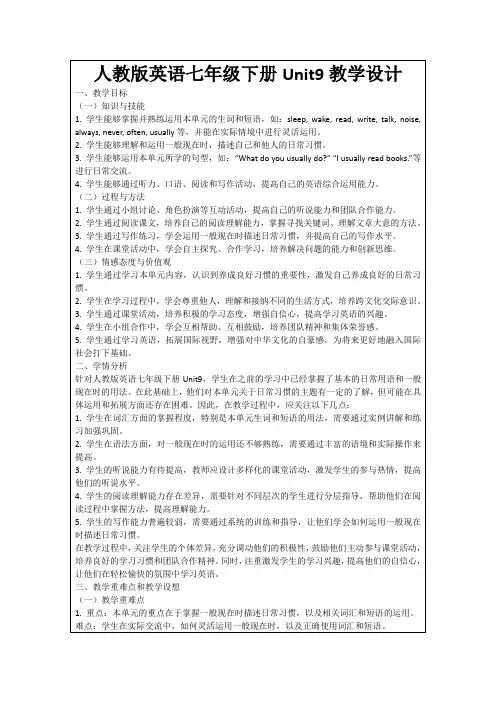
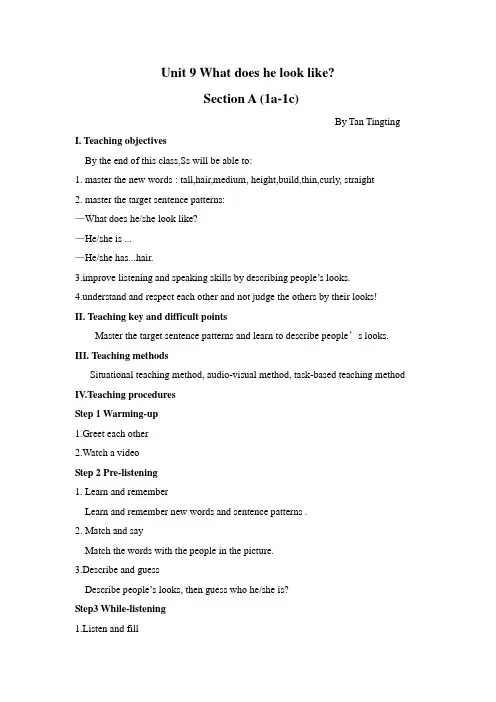
Unit 9 What does he look like?Section A (1a-1c)By Tan Tingting I. Teaching objectivesBy the end of this class,Ss will be able to:1. master the new words : tall,hair,medium, height,build,thin,curly, straight2. master the target sentence patterns:—What does he/she look like?—He/she is ...—He/she has...hair.3.improve listening and speaking skills by describing people’s looks.4.understand and respect each other and not judge the others by their looks!II. Teaching key and difficult pointsMaster the target sentence patterns and learn to describe people’s looks. III. Teaching methodsSituational teaching method, audio-visual method, task-based teaching method IV.Teaching proceduresStep 1 Warming-up1.Greet each other2.Watch a videoStep 2 Pre-listening1. Learn and rememberLearn and remember new words and sentence patterns .2. Match and sayMatch the words with the people in the picture.3.Describe and guessDescribe people’s looks, then guess who he/she is?Step3 While-listening1.Listen and fillListen and fill in the blanks in the picture above.2.Listen and drawDraw the appearance of the person you hear.Step4 Post-listening1.Ask and answerWork in pairs.Ask and answer about friend’s look.2.Interview and reportWork in groups.Interview members’ favorite star in groups, and make a report.Step5 Sum-upSing and sumStep6 HomeworkDraw and finsh the mind map of this class.。
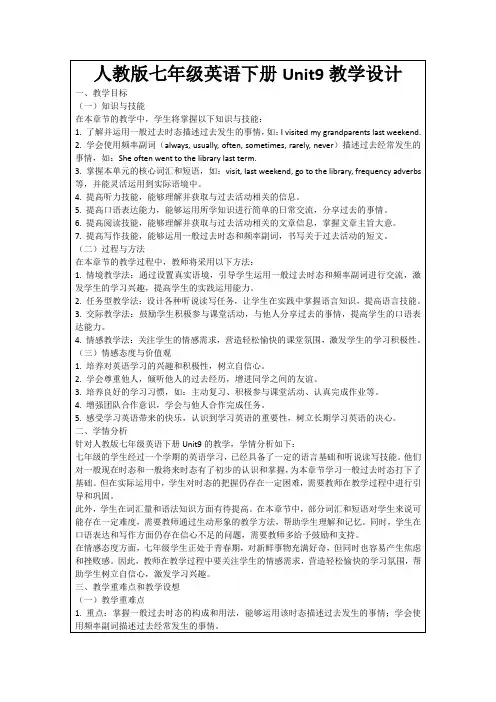
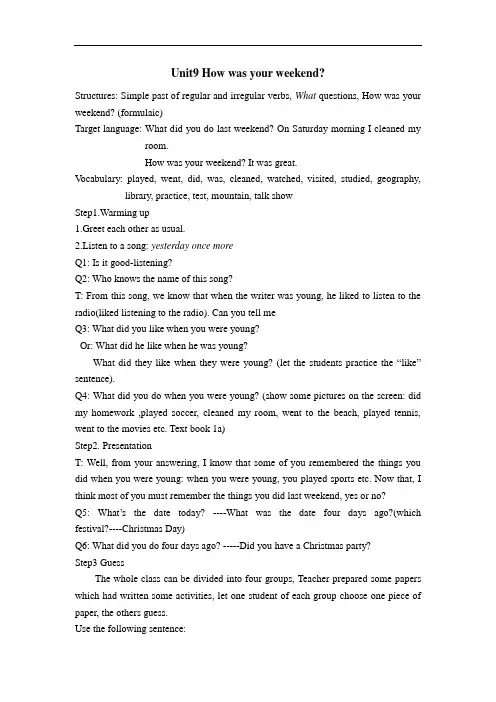
Unit9 How was your weekend?Structures: Simple past of regular and irregular verbs, What questions, How was your weekend? (formulaic)Target language: What did you do last weekend? On Saturday morning I cleaned my room.How was your weekend? It was great.V ocabulary: played, went, did, was, cleaned, watched, visited, studied, geography, library, practice, test, mountain, talk showStep1.Warming up1.Greet each other as usual.2.Listen to a song: yesterday once moreQ1: Is it good-listening?Q2: Who knows the name of this song?T: From this song, we know that when the writer was young, he liked to listen to the radio(liked listening to the radio). Can you tell meQ3: What did you like when you were young?Or: What did he like when he was young?What did they like when they were young? (let the students practice the “like”sentence).Q4: What did you do when you were young? (show some pictures on the screen: did my homework ,played soccer, cleaned my room, went to the beach, played tennis, went to the movies etc. Text book 1a)Step2. PresentationT: Well, from your answering, I know that some of you remembered the things you did when you were young: when you were young, you played sports etc. Now that, I think most of you must remember the things you did last weekend, yes or no?Q5: What’s the date today? ----What was the date four days ago?(which festival?----Christmas Day)Q6: What did you do four days ago? -----Did you have a Christmas party?Step3 GuessThe whole class can be divided into four groups, Teacher prepared some papers which had written some activities, let one student of each group choose one piece of paper, the others guess.Use the following sentence:Q7: Did you do your homework that day?Step4. Talking and have a competitionT: I had a Christmas party on that day, now, have a look, and what’s this? Y es, it’s a Christmas Father’s coat, it’s my gift that I received from that day, and I had a good time on that day.1.Let Ss talk about their Christmas Day or last weekend.2.Let Ss choose “who had the best Christmas Day or last weekend”, why? (Retell the story about their Christmas Day or last weekend).Step5.HomeworkLet Ss write down their great days.。

人教版七年级英语下册第九单元教案Unit 9: What Does He Look Like。
n A (1a-2c)XXX Aims:nguage Goals:New Words: curly。
straight。
tall。
medium。
thin。
heavy。
build。
tonight。
little。
cinema。
glasses。
later.XXX:What does he look like?He's of medium/build.What does she look like?She has long XXX.Is he tall or short?2.XXX:XXX.XXX Points:XXX.Teaching Difficult Points:XXX.res of Teaching:I。
Lead-in:XXX named Nancy and show some pictures to XXX:What does she look like。
She's of medium/build.She has long XXX.II。
n (n A 1a):1.Match the words with the people in the picture。
(1a)XXX's first n on page 49.Then。
match the pictures with the XXX.2.Listen and circle the words you hear。
(1b)Listen to the。
and circle the words that you hear.3.Pairwork (2a-2c)XXX.Please look at page 49 and use the letters to match the peoplein the picture with the numbered words。
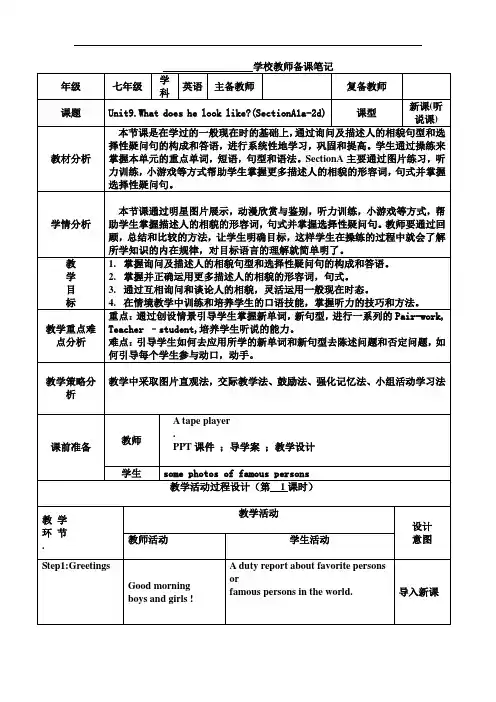
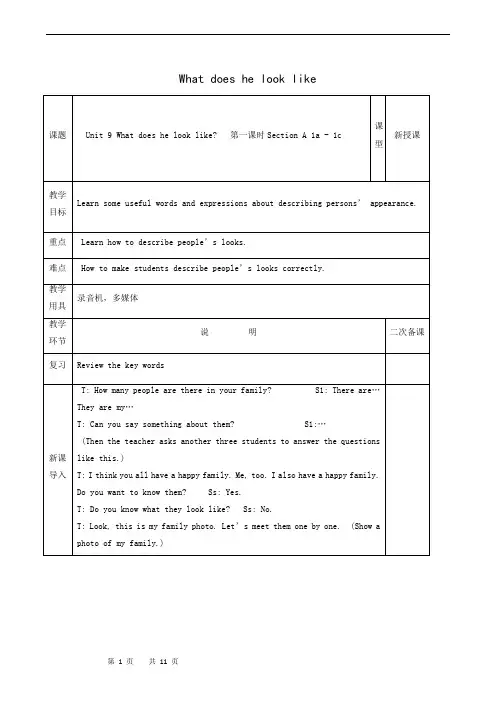
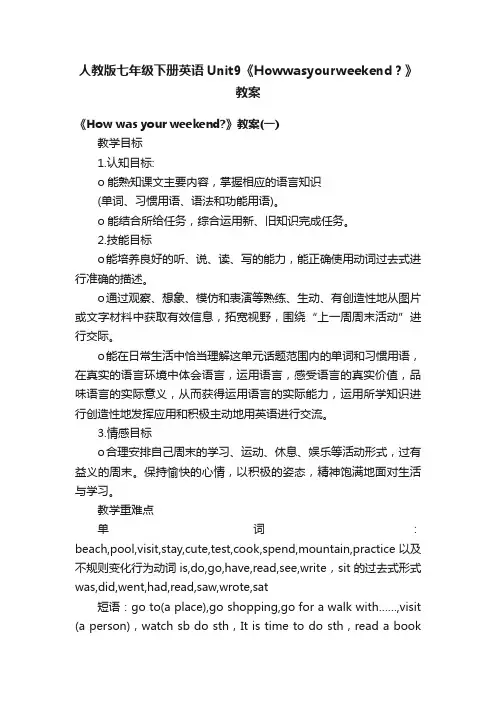
人教版七年级下册英语Unit9《Howwasyourweekend?》教案《How was your weekend?》教案(一)教学目标1.认知目标:o能熟知课文主要内容,掌握相应的语言知识(单词、习惯用语、语法和功能用语)。
o能结合所给任务,综合运用新、旧知识完成任务。
2.技能目标o能培养良好的听、说、读、写的能力,能正确使用动词过去式进行准确的描述。
o通过观察、想象、模仿和表演等熟练、生动、有创造性地从图片或文字材料中获取有效信息,拓宽视野,围绕“上一周周末活动”进行交际。
o能在日常生活中恰当理解这单元话题范围内的单词和习惯用语,在真实的语言环境中体会语言,运用语言,感受语言的真实价值,品味语言的实际意义,从而获得运用语言的实际能力,运用所学知识进行创造性地发挥应用和积极主动地用英语进行交流。
3.情感目标o合理安排自己周末的学习、运动、休息、娱乐等活动形式,过有益义的周末。
保持愉快的心情,以积极的姿态,精神饱满地面对生活与学习。
教学重难点单词:beach,pool,visit,stay,cute,test,cook,spend,mountain,practice以及不规则变化行为动词is,do,go,have,read,see,write,sit的过去式形式was,did,went,had,read,saw,wrote,sat短语:go to(a place),go shopping,go for a walk with……,visit (a person),watch sb do sth,It is time to do sth,read a bookabout(history),see an interesting talk show,study for the(math)test。
教学工具课件教学过程Step1. Revision1. Check the past tense of some words.2. Practice “How was your weekend?”Step2. ExerciseAsk: What did you do yesterday?Let’s see what Sally and Jim did yesterday. Do 1a on P56.Do you like the things they did? Ask: Do you like to play the guitar? … .Listen and write down what Sally and Jim did last weekend and complete the chart.Step3. SurveyInterview your partners about their parents: What did your mother /father do last weekend? Then give us a report: My friend **’s father/mother … last weekend.Step4. ReadingRead 3a by yourself, and circle the activities you like. Underline the activities you don’t like. T hen let the students give their answers.Explain: For most kids.Then ask some students to read the passage.Step5. SurveyWhat did most of you do last weekend? Ask about your friends in your group and give a report:Last weekend, most of us … .Step6. ExerciseDo 3b. First ask questions about the pictures? What is he/she doing?Then fill in the blanks according to the pictures.Step7 Oral WritingCan you introduce your last weekend like 3b?Homework:1. Write about what you did last weekend.2.Do workbook(1) P35 (2)26课后小结学了这节课,你有什么收获?课后习题完成课后练习题。

UNIT 9 What does he look like?Section A 第1课时(1a~1c)自主学习方案1.自学生词,并记住拼读及拼写。
2.预习课本找出重点短语及句子。
(见学案自学导练内容)3.读记后完成自学导练内容。
课堂导学方案Step1 情景导入(Show a picture of a person)T:Do you know how to describe the person’s appearance?Can you say it in English?After this lesson,you can do it,and let’s learn together.环节说明:开门见山地提出本节课要学的语言目标——描述人的外貌。
Step 2完成教材1a—1c的任务1.教师利用图片或指着自己或相对应的同学来领读新单词。
I have short/long …hair. He is heavy/ thin…。
(4分钟)2.让学生把新单词与图画中的人物连接起来,可以重复使用,完成1a。
(2分钟)3.请学生大声朗读1a图片中的对话,了解大意。
(2分钟)4.听录音,根据录音内容,完成1a图片中的填空,找到Amy的朋友,集体核对答案。
(3分钟)5.创设情境。
教师可找一个同学对其描述,或者在黑板上画“简笔画”让同学们描绘。
也可以用多媒体课件展示图片让学生练习描述人物的外貌特征。
6.小结训练。
(分钟)(1)Li Lei B short and straight hair.A. is;isB. is;hasC. has;hasD. is;have(2)— What D your sister ?一She's tall.A. is;look likeB. /;likeC. does ;lookD. does ; look like(3)用is或has填空:①Lei Hao has short and straight hair.②Dick is tall,but his sister is short③Xie Kai is of medium height.④Du Ke is short and thin.环节说明:听说结合,第一时间向学生传达语言目标,通过结对对话练习和小结训练,语言目标得以强化。
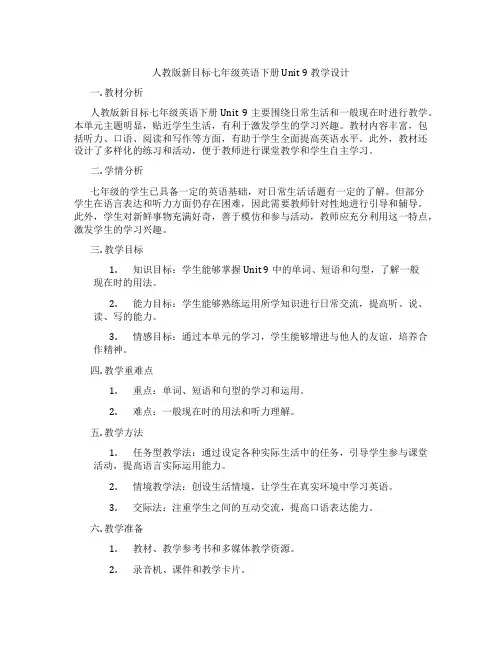
人教版新目标七年级英语下册 Unit 9教学设计一. 教材分析人教版新目标七年级英语下册Unit 9主要围绕日常生活和一般现在时进行教学。
本单元主题明显,贴近学生生活,有利于激发学生的学习兴趣。
教材内容丰富,包括听力、口语、阅读和写作等方面,有助于学生全面提高英语水平。
此外,教材还设计了多样化的练习和活动,便于教师进行课堂教学和学生自主学习。
二. 学情分析七年级的学生已具备一定的英语基础,对日常生活话题有一定的了解。
但部分学生在语言表达和听力方面仍存在困难,因此需要教师针对性地进行引导和辅导。
此外,学生对新鲜事物充满好奇,善于模仿和参与活动,教师应充分利用这一特点,激发学生的学习兴趣。
三. 教学目标1.知识目标:学生能够掌握Unit 9中的单词、短语和句型,了解一般现在时的用法。
2.能力目标:学生能够熟练运用所学知识进行日常交流,提高听、说、读、写的能力。
3.情感目标:通过本单元的学习,学生能够增进与他人的友谊,培养合作精神。
四. 教学重难点1.重点:单词、短语和句型的学习和运用。
2.难点:一般现在时的用法和听力理解。
五. 教学方法1.任务型教学法:通过设定各种实际生活中的任务,引导学生参与课堂活动,提高语言实际运用能力。
2.情境教学法:创设生活情境,让学生在真实环境中学习英语。
3.交际法:注重学生之间的互动交流,提高口语表达能力。
六. 教学准备1.教材、教学参考书和多媒体教学资源。
2.录音机、课件和教学卡片。
3.学生分组,准备角色扮演等活动。
七. 教学过程1.导入(5分钟)教师通过与学生打招呼,询问身体状况等日常话题,引入本课主题。
引导学生谈论日常生活中的一般现在时,激发学生学习兴趣。
2.呈现(10分钟)教师展示课件,呈现Unit 9的单词、短语和句型。
通过图片、例句等方式,对新词汇和短语进行讲解,让学生初步感知和理解。
3.操练(10分钟)教师学生进行口语练习,运用新学的单词、短语和句型进行角色扮演。
【更新】人教版七年级下册英语Unit9第九单元优秀教案一、教学目标1. 掌握单词:hope, future, astronaut, enjoyable, unhappy2. 能够流利地运用一般将来时来表达将来的计划和希望3. 能够听懂并理解关于未来的对话和问题4. 能够合作完成与未来规划相关的活动二、教学重点1. 研究、掌握一般将来时的用法2. 培养学生对未来计划和希望的表达能力三、教学准备1. 学生课本和练册2. 多媒体设备和教学投影仪四、教学过程1. 导入(5分钟)引导学生讨论一下他们的未来计划和希望,激发学生研究的兴趣和积极性。
2. 教学主体(30分钟)a. 复和引入新知识通过多媒体展示相关图片,引入新单词和短语,并帮助学生掌握其含义。
b. 教授一般将来时的用法详细解释一般将来时的构成和用法,例如:主语 + will + 动词原形。
通过示例句子和练帮助学生理解和掌握。
c. 练与拓展让学生进行口头和书面练,练运用一般将来时进行句子构造和对话。
同时,组织小组活动,让学生合作讨论自己的未来计划。
3. 巩固与反馈(15分钟)通过问题和对话练,巩固学生对一般将来时的掌握程度。
同时,对学生的合作活动进行评价,并给予反馈和鼓励。
五、教学延伸鼓励学生在家进行额外的练,巩固所学的知识。
可以提供一些相关的练题和研究资源。
六、教学评价通过对学生的口头和书面练进行评价,了解学生对一般将来时的掌握程度,并给予针对性的指导。
七、教学反思根据教学实际情况,对本节课的教学效果进行总结和反思,为下一次教学做出调整和提升。
八、课后作业完成课本和练习册上相关的练习题,并继续思考自己的未来计划和希望。
Unit9 What does he look like?I.Warm-up1.There be句型2.Where引导的特殊疑问句II.Presentation重点句型:1.What does/do+主语+look like?……看上去怎么样?2.sb.+ be+ of+ medium build/height 某人中等身材/个子3.sb.+ has+…hair 某人留着……发知识点:1. 形容词1). 形容头发:__________ __________ __________ __________2). 形容身材:__________ __________ __________ __________ __________ __________2. a little 意为“有点儿”,用来修饰形容词。
例如:It’s a little cold tonight.a little 意为“一些;少许”后跟不可数名词。
例如:There’s a little meat in the bowl.碗里有点肉。
3. glass 作“玻璃”讲时,是不可数名词;作“玻璃杯”讲时为可数名词;而glasses则是“眼镜”之意。
例如:Glass is broken easily. There’s no water in your glasses.玻璃很易碎。
你的杯子里没有水了。
Does she wear glasses?她戴眼镜吗?4. describe people’s looks.看起来像____________________ 短发___________________ 卷发____________________中等个子___________________中等身材___________________一点;少量________________大鼻子________________小嘴________________圆脸________________警察画家________________一张罪犯的图片或肖像____________________________最后________________擅长________________去看电影____________________黑发________________长脸________________长发________________直发________________有点________________大眼睛________________同样的方式________________ 金黄色的头发____________________今晚你要去看电影吗?_______________________________________________我可能会有点迟_______________________________________________他不高不矮_______________________________________________人们并非总是以同样的方式看待事物,所以他们会将同一个人描述的不一样。
【精心编写】人教版七年级下册英语
Unit9第九单元优秀教案
精心编写:人教版七年级下册英语Unit9第九单元优秀教案
教学目标
1. 研究并能够正确使用以下问句:
- What are you going to do this afternoon?
- Are you going to watch TV?
- Where are you going to go on vacation?
- When are you going to visit your grandparents?
2. 能够听懂和表达关于未来计划的简单对话。
教学重点
- 能够正确使用四个问句。
- 能够听懂和表达关于未来计划的简单对话。
教学难点
- 能够准确使用一般将来时。
教学准备
教师准备课件,学生准备笔记和课本。
教学过程
导入新课
通过歌曲《Let's Talk About Future》(自选),引入新课内容,激发学生的研究兴趣。
学生跟唱歌曲,感受英语语言魅力。
展示新知识
在课件上展示四个问句,并讲解其用法和构造方法。
让学生进
行口语练。
练
1. 给学生一张工作表,完成其中的口语练。
2. 让学生自己编写对话使用所学问句,进行小组表演。
总结
复今天的研究内容,简要介绍一般将来时,让学生用自己的语
言给同桌讲解。
教学后记
本节课教学目标明确,操作简单易行。
学生在课上积极参与,课上练习及小组表演表现出色,达到了预期的教学效果。
最新人教版七年级英语下册第九单元教案Unit 9 What does he look like?Section A (1a-2c)一、Teaching aims1. Language goals1) New words:curly, straight, tall, medium, thin, heavy, build, tonight, little, cinema, glasses, laterSentences:—What does he look like?—He’s of medium/build.—What does he look like?—She has long straight hair.—Is he tall or short?2. Teaching emotion and valueMake students describe the people’s looks.二、Teaching key pointsGrasp the new words and the sentences.三. Teaching difficult points:What does he look like?He has long straight hair.四、Procedures of teachingⅠ. Lead-inI have a new friend, her name is Nancy. Do you want to know her? Then show some pictures to lead in the new sentences: What does she look like? Sh e’s of medium/build.She has long straight hair.…Ⅱ. Presentation (Section A 1a)1. Match the words with the people in the picture. (1a)学习课本的第一部分P49,1a先看图片,然后搭配图片和相关的外貌特征的词。
Unit 9 What does he look like?Section A (1a-2c)一、Teaching aims1. Language goals1) New words:curly, straight, tall, medium, thin, heavy, build, tonight, little, cinema, glasses, laterSentences:—What does he look like?—He’s of medium/build.—What does he look like?—She has long straight hair.—Is he tall or short?2. Teaching emotion and valueMake students describe the people’s looks.二、Teaching key pointsGrasp the new words and the sentences.三. Teaching difficult points:What does he look like?He has long straight hair.四、Procedures of teachingⅠ. Lead-inI have a new friend, her name is Nancy. Do you want to know her? Then show some pictures to lead in the new sentences:What does she look like? Sh e’s of medium/build.She has long straight hair.…Ⅱ. Presentation (Section A 1a)1. Match the words with the people in the picture. (1a)学习课本的第一部分P49,1a先看图片,然后搭配图片和相关的外貌特征的词。